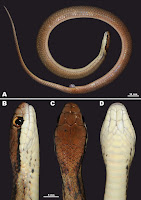 |
| Liopeltis pallidonuchalis
Poyarkov, Nguyen & Vogel, 2019
|
ABSTRACT
A new species of Liopeltis from central Vietnam is described based on morphological and molecular differences. Liopeltis pallidonuchalis sp. nov. is distinguished from its congeners by a combination of the following characters: one single (or missing) loreal; one single nasal shield; dorsal scales in 15–15-15 rows, all smooth; 1 preocular, 2 postoculars and 1 + 2 temporals; 7 supralabials, of which 3rd and 4th in contact with the eye; 8 infralabials; nasal contacting internasal; prefrontal touching or separated from supralabials; ventral scales 126–138; subcaudal scales 67–73, paired; relative tail length about 0.274–0.301; an uniform bronze body colouration; a thin postocular stripe extending from eye to end of the neck becoming indistinct posteriorly. The new species differs from the morphologically closest species Liopeltis frenata by the lower number of ventrals and subcaudals, by characteristic colouration and significant divergence in cytochrome b mtDNA gene sequences (p = 15.3–15.6%). The new species is currently known from northen and central parts of the Annamite (Truong Son) Mountains, central Vietnam, and was recorded from montane evergreen tropical forests of Kon Tum–Gia Lai Plateau (Gia Lai and Thua Thien–Hue provinces, Da Nang City) at elevations of 950–1010 m asl to karst tropical forests in Quang Binh Province in the north at elevation 150 asl. We suggest the new species should be considered as Vulnerable (VU) following the IUCN’s Red List categories. An updated taxonomic key to the Liopeltis species is provided.
KEYWORDS: Liopeltis pallidonuchalis sp. nov, Gongylosoma, Colubroidea, Gongylosoma, systematics, morphology, cyt b
 |
| Known distribution of Liopeltis frenata and related taxa. Star denotes type locality. Question mark denotes and unconfirmed record of Liopeltis cf. frenata from Bhutan. |
 |
| Figure 4. Holotype of Liopeltis pallidonuchalis sp. nov. in situ (ZMMU R-15682, male).
Photo by Nikolay A. Poyarkov.
|
Systematics
Family COLUBRIDAE Oppel 1811
Genus Liopeltis Fitzinger, 1843
Liopeltis pallidonuchalis sp. nov.
Chresonymy Liopeltis frenatus (partim) – Smith (1943): 183; Ziegler et al. (2007): 10–11, Figure 11 (?); Ziegler and Hoang (2009): 115.
Diagnosis. The new species can be separated from its congeners by the following combination of morphological characters: (1) one single (or missing) loreal; (2) one single nasal shield; (3) dorsal scales in 15-15-15 rows, all smooth; (4) 1 preocular, 2 postoculars and 1 + 2 temporals; (5) 7 supralabials, of which 3d and 4th in contact with the eye; (6) 8 infralabials; (7) nasal contacting internasal; (8) prefrontal touching or separated from supralabials; (9) ventral scales 126–138; (10) subcaudal scales 67–73, paired; (11) relative tail length about 0.274–0.301; (12) an uniform bronze body colouration; (13) a thin postocular stripe extending from eye to end of the neck becoming indistinct posteriorly. The new species can be distinguished from all other congeners by its low subcaudal scales count, and by its characteristic colouration. Detailed comparisons with other species of the genus Liopeltis appear below.
 |
| Figure 3. Hemipenial morphology of Liopeltis pallidonuchalis sp. nov. holotype (ZMMU R-15682, male). (a) – asulcal side; (b) – sulcal side.
Photos by Nikolay A. Poyarkov.
|
Etymology. The specific name ‘pallidonuchalis’ is a Latinised adjective in the nominative singular (feminine gender), derived from Latin ‘pallidus’ for ‘pale’ and Medieval Latin ‘nucha’, derived from Arabic ‘nuka’ for ‘nape’, ‘dorsal surface of neck’, referring to the pale postocular marking of the new species disappearing in nuchal area.
We suggest the following common names: Pale-necked Ringneck (English), Rắn đai gáy nhạt màu (Vietnamese), Blednyi Gladkiy Kamyshovyi Uzh (Russian), Blasse Halsbandnatter (German).
 |
| Figure 6. Natural habitat of Liopeltis pallidonuchalis sp. nov. in Kon Chu Rang N.R., Gia Lai Province, Vietnam.
Photo by Alina V. Alexandrova.
|
Nikolay A. Poyarkov Jr.,Tan Van Nguyen and Gernot Vogel. 2019. A New Species of the Genus Liopeltis Fitzinger, 1843 from Vietnam (Squamata: Colubridae).Journal of Natural History. 53(27-28); 1647-1672.DOI: 10.1080/00222933.2019.1656784



